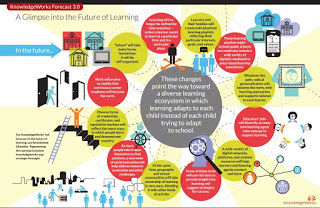Happy American Education Week! To help us celebrate, Katherine Prince of KnowledgeWorks invites you to join her on an exploratory mission to 2025–a future of education in which museums play a starring role. You can review CFM’s work with Knowledgework on this topic in the report Building the Future of Education: Museums and the Learning Ecosystem. Follow Katherine and KnowledgeWorks on Twitter and comment below to help build the next era of learning.
Let’s look ahead to possibilities for learning in 2025 and how museums might contribute to creating resilient learning ecosystems that help communities, individuals, and the education sector adapt to changing needs. What if…
…Public funding for community-wide learning venues such as museums, libraries, and parks were viewed as being an integral part of the investment in public education?
…The health of an education organization or system were measured by the strength of its relationships with varied partners?
Such changes could emerge from moving toward viewing learning institutions, including museums, as standalone structures, to treating them as interconnected contributors to flexible value webs comprised of many kinds of organizations and resources. In a vibrant learning grid or ecosystem, learners could move smoothly across such value webs, accessing the experiences and resources they needed when and in ways that made sense for them. And learning ecosystems would have greater resilience in navigating system shocks that are likely to result as people navigate increasingly volatile conditions resulting from the changing nature of work, growing income disparity, and increasing environmental volatility.
 |
| An Infographic from KnowledgeWorks’ 3.0 Forecast Report….keep an eye out for 4.0 ! |
KnowledgeWorks’ forthcoming forecast, The Future of Learning: Education in the Era of Partners in Code, explores such possibilities for education in 2025 and invites each of us to consider what role we might play in shaping the future of learning. I think that museums could be critical in fostering new approaches to making learning ecosystems vibrant for all young people, both by bringing more learners to their buildings in more flexible ways and by surfacing their resources for use in other places.
Think way beyond traditional field trips or even today’s movement toward sharing museum assets as open education resources or creating city-wide networks of extended learning opportunities. Think custom learning journeys that learners and their families craft with learning pathway designers and which many kinds of learning journey mentors help learners carry out. Think pop-up reality productions that immerse young people in learning, if only for a brief time. Think fluid school structures based around networks and relationships instead of fixed places. Think community-wide competency maps that surface the resources available to support learning and help people understand how and when they might be used.
Some moves are already afoot to foster broadly defined, interconnected learning ecosystems. For example:
· Cities of Learning is a national U.S. effort to surface and connect cities’ many resources helps youth of all backgrounds develop curiosity, resilience, and 21stcentury skills. How might museums extend current efforts to link up learning across communities?
· The Tiny Schools Project from 4.0 Schools supports entrepreneurs in testing new types of schools at small scale before attempting to extend their reach, with ten to fifteen students and their families giving high-frequency feedback on pilots that challenge fundamental assumptions about how school works today. What roles might museums play if school looked different? When and in what ways could going to a museum be “school”?
· Through Next-Gen Learning Hubs, six U.S. regions are building off cities’ assets and bringing together partners to create innovative student-centered learning ecosystems. How might museums help make education more personalized and more passion-based?
These are just some developments emerging today. Looking beyond them to the promise of a vibrant learning grid of 2025, what might it take for museums to play a central role in making learning ecosystems more resilient? What might that mean not just for how museums operate but also for how they are funded and evaluated?
To explore such possibilities further, sign upto get alerted when The Future of Learning: Education in the Era of Partners in Code launches in early December.
Elizabeth Merritt












Imagine many smaller schools groups of K-12 in which there are no drop outs and every kid goes to college. Where the older kids help educate the younger ones (often brothers and sisters and relatives) and set behavior examples for the middle graders.
Such schools exist, they are public schools, often in rural areas and of average or lower income. Where every aspect of a community are utilized educate kids and athletic pride is every kid because there are no elite kids–there are not enough numbers for stud athletes.